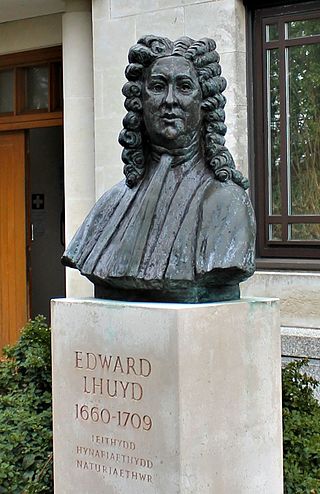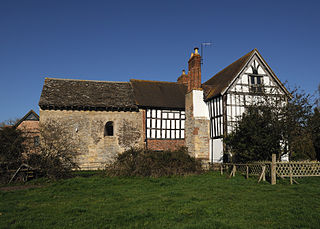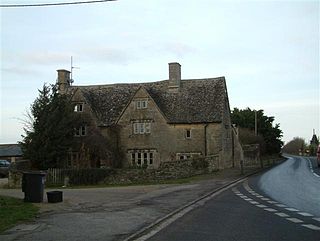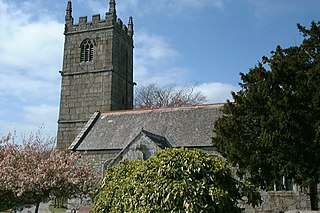
Odda's Dedication Stone is an Anglo-Saxon object in the Ashmolean Museum in Oxford, England. It bears an inscription regarding the dedication of a chapel at Deerhurst, Gloucestershire. The building, known as Odda's Chapel, still exists.

Odda's Dedication Stone is an Anglo-Saxon object in the Ashmolean Museum in Oxford, England. It bears an inscription regarding the dedication of a chapel at Deerhurst, Gloucestershire. The building, known as Odda's Chapel, still exists.
The limestone slab bears an 11th-century inscription in Latin relating to the dedication of a chapel built by Earl Odda. [1]
There is evidence that the stone remained fixed to the chapel for centuries, but it became detached. [2] In 1675 Sir John Powell discovered the stone on his property at Deerhurst. He gave it to the University of Oxford.
The Latin text is available at the Ashmolean Latin Inscriptions Project. [2] The inscription translates as follows:
"Earl Odda ordered this royal hall to be built and dedicated in honour of the Holy Trinity for the soul of his brother Ælfric, taken up from this place. Ealdred was the bishop who dedicated the building on the second day before Ides of April in the fourteenth year of the reign of Edward, king of the English". [1]
"Odda's Stone" is on display in the Ashmolean Museum. [1] A replica has been placed in Odda's Chapel, the building to which the inscription refers.

Edward the Confessor was an Anglo-Saxon English king and saint. Usually considered the last king of the House of Wessex, he ruled from 1042 until his death in 1066.

Deerhurst is a village and civil parish in Gloucestershire, England, about 2 miles (3 km) southwest of Tewkesbury. The village is on the east bank of the River Severn. The parish includes the village of Apperley and the hamlet of Deerhurst Walton. The 2011 Census recorded the parish's population as 906, the majority of whom live in Apperley.

Coventina was a Romano-British goddess of wells and springs. She is known from multiple inscriptions at one site in Northumberland, England, an area surrounding a wellspring near Carrawburgh on Hadrian's Wall. It is possible that other inscriptions, two from Hispania and one from Narbonensis, refer to Coventina, but this is disputed.

The Ashmolean Museum of Art and Archaeology on Beaumont Street, Oxford, England, is Britain's first public museum. Its first building was erected in 1678–1683 to house the cabinet of curiosities that Elias Ashmole gave to the University of Oxford in 1677. It is also the world's second university museum, after the establishment of the Kunstmuseum Basel in 1661 by the University of Basel.

Anglo-Saxon architecture was a period in the history of architecture in England from the mid-5th century until the Norman Conquest of 1066. Anglo-Saxon secular buildings in Britain were generally simple, constructed mainly using timber with thatch for roofing. No universally accepted example survives above ground. Generally preferring not to settle within the old Roman cities, the Anglo-Saxons built small towns near their centres of agriculture, at fords in rivers or sited to serve as ports. In each town, a main hall was in the centre, provided with a central hearth.

The Arundel marbles are a collection of stone Roman and Ancient Greek sculptures and inscriptions collected by Thomas Howard, 21st Earl of Arundel in the early seventeenth century, the first such comprehensive collection of its kind in England. They are now in the Ashmolean Museum, Oxford, having been donated in two groups.

Edward Lhuyd, also known as Edward Lhwyd and by other spellings, was a Welsh naturalist, botanist, herbalist, alchemist, scientist, linguist, geographer, and antiquary. He was the second Keeper of the University of Oxford's Ashmolean Museum, and published the first catalogue of fossils, the Lithophylacii Britannici Ichnographia.

Oxford Castle is a large, partly ruined medieval castle on the western side of central Oxford in Oxfordshire, England. Most of the original moated, wooden motte and bailey castle was replaced in stone in the late 12th or early 13th century and the castle played an important role in the conflict of the Anarchy. In the 14th century the military value of the castle diminished and the site became used primarily for county administration and as a prison. The surviving rectangular St George's Tower is now believed to pre-date the remainder of the castle and be a watch tower associated with the original Saxon west gate of the city.

Apperley is a village in Gloucestershire, England, about 3 miles (5 km) southwest of Tewkesbury, 1 mile (1.6 km) south of Deerhurst and 1⁄3 mile (0.5 km) east of the River Severn. It is the largest settlement in Deerhurst civil parish. In 2020 it had an estimated population of 625.

Broad Street is a wide street in central Oxford, England, just north of the former city wall. The street is known for its bookshops, including the original Blackwell's bookshop at number 50, located here due to the University of Oxford. Among residents, the street is traditionally known as The Broad.

Odda's Chapel is a former chantry chapel at Deerhurst, Gloucestershire. It is an 11th-century late Anglo-Saxon building, completed a decade before the Norman Conquest of England.

The Mond Crucifixion or Gavari Altarpiece is an oil on poplar panel dated to 1502–1503, making it one of the earliest works by Italian Renaissance artist Raphael, perhaps the second after the c.1499-1500 Baronci Altarpiece. It originally comprised four elements, of which three survive, now all separated: a main panel of the Crucified Christ with the Virgin Mary, Saints and Angels which was bequeathed to the National Gallery, London, by Ludwig Mond, and a three-panel predella from which one panel is lost; the two surviving panels are Eusebius of Cremona raising Three Men from the Dead with Saint Jerome's Cloak in the Museu Nacional de Arte Antiga, in Lisbon, and Saint Jerome saving Silvanus and punishing the Heretic Sabinianus in the North Carolina Museum of Art.

The Pilate stone is a damaged block of carved limestone with a partially intact inscription attributed to, and mentioning, Pontius Pilate, a prefect of the Roman province of Judea from AD 26 to 36. It was discovered at the archaeological site of Caesarea Maritima in 1961. The artifact is particularly significant because it is an archaeological find of an authentic 1st-century Roman inscription mentioning the name "[Pon]tius Pilatus". It is contemporary to Pilate's lifetime, and accords with what is known of his reported career. In effect, the inscription constitutes the earliest surviving, and only contemporary, record of Pilate, who is otherwise known from the New Testament and apocryphal texts, the Jewish historian Josephus and writer Philo, and brief references by Roman historians such as Tacitus.

Woodeaton or Wood Eaton is a village and civil parish about 4 miles (6.4 km) northeast of Oxford, England. It also has a special needs school called Woodeaton Manor School.

St Mary's Priory Church, Deerhurst, is the Church of England parish church of Deerhurst, Gloucestershire, England. Much of the church is Anglo-Saxon. It was built in the 8th century, when Deerhurst was part of the Anglo-Saxon kingdom of Mercia. It is contemporary with the Carolingian Renaissance on mainland Europe, which may have influenced it.

Brighthampton is a hamlet which is contiguous with the village of Standlake, about 4 miles (6.4 km) south of Witney, in West Oxfordshire, in the county of Oxfordshire, England.

Odda of Deerhurst was an Anglo-Saxon nobleman active in the period from 1013 onwards. He became a leading magnate in 1051, following the exile of Godwin, Earl of Wessex and his sons and the confiscation of their property and earldoms, when King Edward the Confessor appointed Odda as earl over a portion of the vacated territory. Earl Godwin was later restored to royal favour, and his lands returned, while Odda received a new earldom in the west midlands in compensation. Odda became a monk late in life. He was buried at Pershore Abbey.
John Powell (1645–1713), of Gloucester, was an English politician and lawyer.

St Mary's Watford is a Church of England church in Watford, Hertfordshire, in England. It is an active church situated in the town centre on Watford High Street, approximately 25 kilometres (16 mi) outside London. St Mary's is the parish church of Watford and is part of the Anglican Diocese of St Albans. Thought to be at least 800 years old, the church contains burials of a number of local nobility and some noteworthy monumental sculpture of the Elizabethan and Jacobean eras.

St Erth’s Church, St Erth, is a Grade I listed parish church in the Church of England Diocese of Truro in St Erth, Cornwall, England, UK.